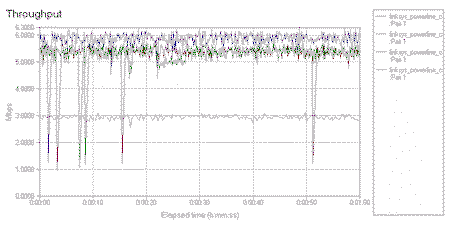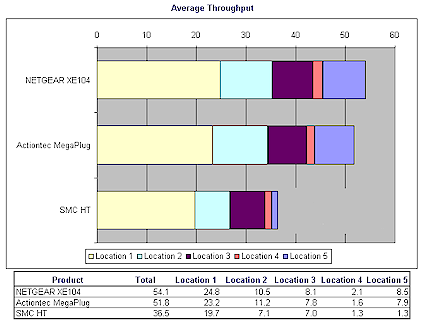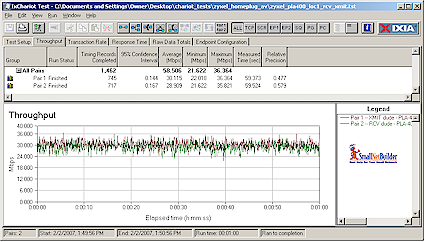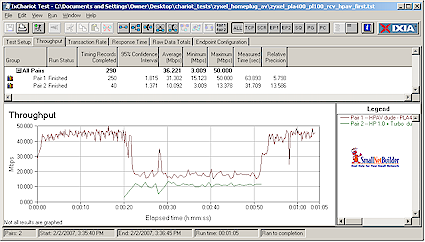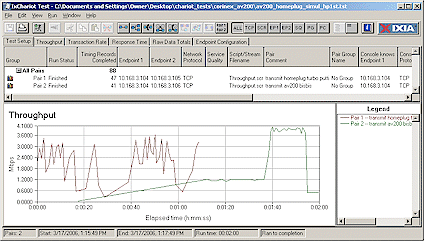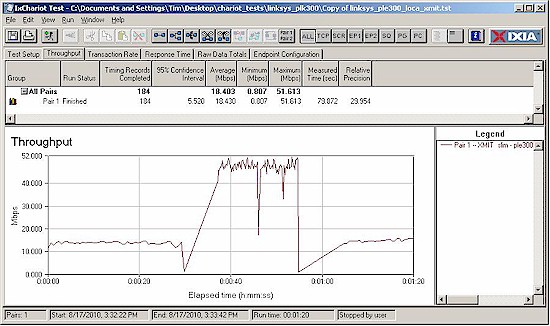Powerline networking can deliver higher and more consistent throughput than wireless, but it can take some tweaking. These tips will show you how to improve your HomePlug network speed.
1. Upgrade to 200 Mbps Powerline
If you still have original HomePlug (14 Mbps) or even HomePlug "Turbo" (85 Mbps) gear and you’re trying to use it to stream HD video, you’re fighting a losing battle. Original HomePlug adapters yield only around 5 Mbps of usable throughput (Figure 1).
Figure 1: Linksys PLEBR10 throughput
[from
Linksys Instant PowerLine EtherFast 10/100 Bridge review]
While "Turbo" adapters are able to deliver best case (same room) speeds in the low 20 Mbps range, average room-to-room speeds quickly move down to 10 Mbps or so (Figure 2)
Figure 2: HomePlugTurbo Adapter Throughput results
[from HomePlug Turbo Adapter Round-Up]
Both of these speeds are too low to support the 20+ Mbps required for 720p HD streams. But HomePlug AV (200 Mbps) adapters can deliver best case speeds of 60+ Mbps (Figure 3). Even when degraded by 50%, these speeds are fine for 720 and even some 1080p HD streaming applications.
Figure 3: ZyXEL PLA-400 throughput
2. Don’t Mix HomePlug Adapter Types
Although implied by solution 1, I’ll say it explicitly: get rid of older versions of HomePlug adapters and standardize on 200 HomePlug AV. There are two reasons why this is a good idea. First, HomePlug AV can coexist with HomePlug and HomePlug Turbo, but not interoperate.
"Coexist" means that both flavors will work, but only with like adapters. (Actually original HomePlug and HomePlug Turbo will also interoperate, but with reduced performance). But "coexist" doesn’t mean that the different generations of HomePlug gear will play nice.
Figure 4 shows around 60% reduction in HomePlug AV throughput when HomePlug Turbo devices become active at the same time.
Figure 4: HomePlug Turbo / AV Coexistence – HPAV first
[from Zyxel PLA-400: Putting HomePlug AV into the game]
No interoperation means you won’t get a connection between gear connected with HomePlug AV adapters and those connected with older types.
3. Don’t Mix HomePlug and DS2
As is their way, consumer networking companies prefer to create their own branding for products, instead of emphasizing compliance with industry standards. So if you’re looking for "HomePlug AV" in product names, you won’t often find it.
Instead, you’ll find some combination of "Powerline", "AV" and "200" in product names and, if you’re lucky and look very closely, some reference to HomePlug AV in small print somewhere on the product box sides or back.
Unfortunately, there are two "200 Mbps" powerline networking technologies: HomePlug AV and DS2 (also sometimes known as UPA (Universal Powerline Association). As you might guess, these two technologies don’t play well together. (An example of a DS2 / UPA product is NETGEAR’s HDXB101 Powerline HD Ethernet Adapter kit.
Figure 5 shows what happened when I tried to run a pair of DS2 and a pair of HomePlug Turbo adapters that were plugged into my home’s outlets at the same time. Note that I wasn’t trying to pass data between the HomePlug and DS2 adapters, I was just trying to run them in parallel.
Figure 5: HomePlug Turbo and DS2 battling for bandwidth
[From Corinex AV200 Powerline And CableLAN Set The Pace For Alternative Home Networking]
Figure 5 shows the two technologies battling so badly that neither could operate reliably, i.e. they would neither interoperate nor coexist.
I’m told that changes have been made so that DS2 and HomePlug adapters will now at least coexist and let each other operate. But you’ll still suffer performance degradation if both powerline networking flavors are in simultaneous use.
4. Watch Out For AFCI Breakers
During previous HomePlug AV testing, I discovered an important source of powerline network signal attenuation. In the U.S., the National Electrical Code (NEC) has mandated the use of AFCI (Arc Fault Circuit Interrupter) circuit breakers to protect bedroom outlets for new residential construction as of January 1, 2002.
Figure 6 shows that AFCI breakers are easy to identify in your home’s circuit breaker panel.
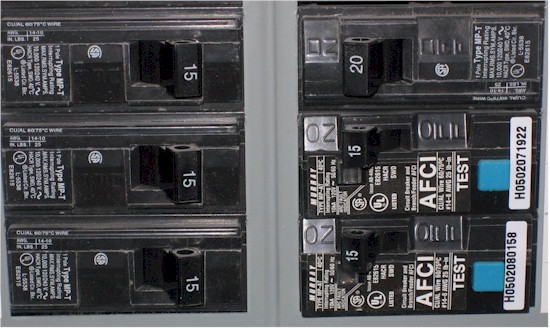
Figure 6: Regular and AFCI circuit breakers
Putting a powerline networking adapter on a circuit protected by an AFCI breaker can easily knock throughput down by 50% or more. Figure 7 shows a quick experiment with an IxChariot throughput test running between two Cisco Linksys PLK300 kit HomePlug AV adapters.
The plot starts with one adapter connected to the outlet just outside my office, which is protected by a normal circuit breaker, and the other adapter connected to an outlet less than 6 feet away inside my office, which is behind an AFCI breaker. I then moved the adapter outside my office to the same outlet where the other adpater was plugged in (inside my office), then back to the hallway outlet again.
Figure 7: AFCI throughput reduction
Eyeballing the plot shows throughput went from around 15 Mbps up to ~ 50 Mbps and back again, which is ~70% change!
Fortunately, I found out from an Atheros contact (formerly from Intellon, which was acquired by Atheros) that all AFCI breakers are not the same. Here’s what he said:
AFCI circuit breakers can harm HomePlug signals depending on the design of the breaker. If the design has an inductor in front of the power supply bridge, there is little if any impact on HomePlug signals.
Square D and Eaton AFCIs have this arrangement and are very HomePlug-friendly; it is fortunate that these brands have a large market share. Some other manufacturers (such as Siemens) have a capacitor in front and this is detrimental to HomePlug signals.
You can include Murray AFCIs, which are in my home, in the "bad AFCI" list, too. I priced Square D replacements at around $50 each, so I haven’t yet swapped out the Murrays! But all of my HomePlug test locations are no longer behind any AFCI outlets.
Note: The 2008 NEC expanded the mandated use of AFCI breakers to include hallways, family rooms, closets and many other areas. This isn’t effective in all states, yet, but it is coming.
5. Find and Filter Noise sources
Electrical noise on the powerline has always had the potential to reduce powerline network performance. But it can be difficult to track down and its effect varies. But, once again, when noise does have an effect, it can be significant.
Noise that can knock down your powerline network throughput can come from things that may not be obvious. And some obvious sources sometimes don’t have much of a negative effect.
In my tests, motor noise from hair dryers and power tools didn’t seem to have much detrimental effect on powerline network throughput. On the other hand, I have found that light dimmers connected to halogen lamps can have an effect.
An innocent looking cellphone charger sitting in a kitchen outlet turned out to be the culprit that was affecting throughput testing in one of my test locations. I also found that my plasma TV sourced enough noise to prevent effective HD streaming via powerline to it.
The only way to find the sources that can be affecting your powerline network is to carefully look for them and then run throughput experiments using a tool like LAN Speed Test, or better NetStress. [see How Fast Is Your Network? Five Ways To Measure Network Speed].
Make sure you run a long enough test so that you get a good throughput average in each case. Some throughput loss can be intermittent and hard to find using a short test.
Once you find the offending noise source, you’ll need to filter it. Fortunately, powerline adapter manufacturers are starting to address this by building filtered outlets right into the adapters.
I haven’t yet tested NETGEAR’s XAVB2501 AV+ 200 kit, which has filtered outlets. But I have found that Plaster Networks IX2 Isolator (Figure 8) was very effective in preventing my tiny little cellphone adapter from reducing powerline throughput.
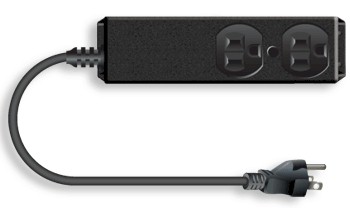
Figure 8: Plaster Networks IX2 Isolator
It’s a tad expensive at $25 and its form factor isn’t ideal in some cases. But Corinex also makes a powerline noise filter (CXZCXPPWR) that’s cheaper, too. If you know of more, please let me know.

